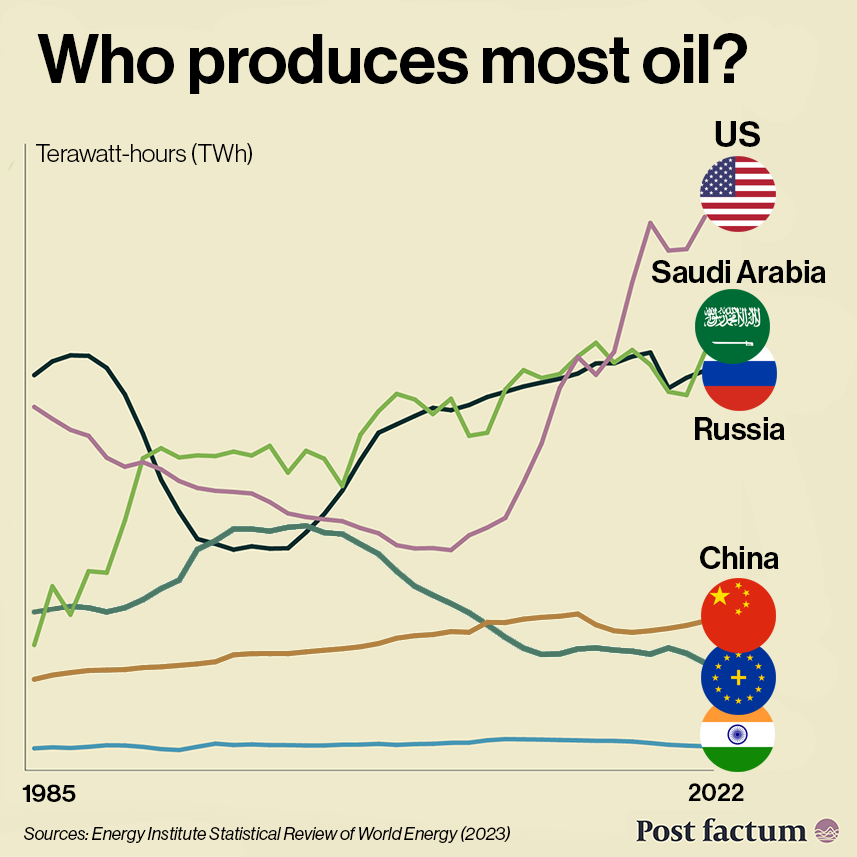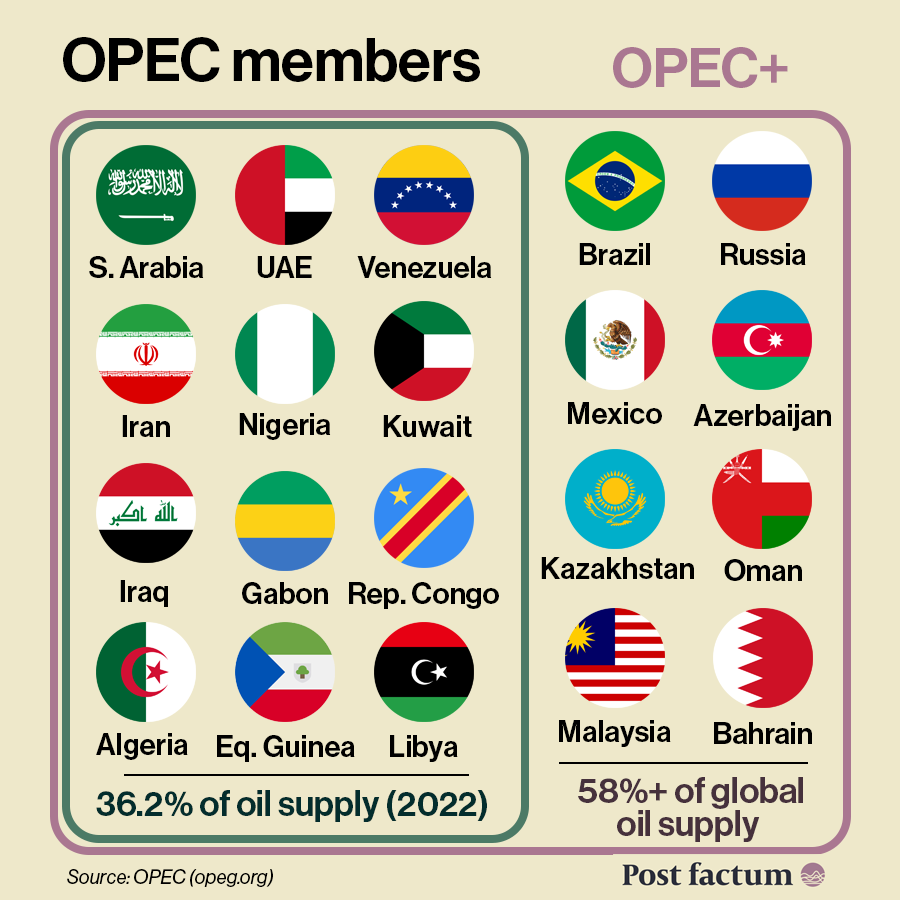oil price, explained
If you share our passion for global trends, you probably read a fair share of news. We want to help you get more value out of them. One way to do so is having a strong grasp of the basics, founded on reliable data and simple logic. Today, we talk about crude oil.
Why are oil prices so important?
Almost a third of all the energy used by humans comes from oil.
The majority of cars, planes and ships run only on fuels made from oil (or petroleum) - like gasoline, kerosene or diesel.
When electricity is used for energy instead of fuel it likely comes from a power plant burning gas, which is often extracted together with crude oil.
As a result, any economy relies on there being enough oil available to grow or at least maintain itself.
Apart from energy sources, oil is used to make plastics, as well as fertilisers, cleaning products and medicines.
This means that oil is a component of almost any product or service, through the cost of either transportation or materials, or, most likely, both.
There are very little substitutes for crude oil, as alternative plastics or biomass petroleum remain fringe technologies.
Changes in oil price, therefore, strongly affect all prices in the economy.
An increase in the price of crude oil reliably creates inflationary pressure, as producers experience higher costs and raise prices.
Oil price falling, however, does not reduce inflation reliably, as sellers tend to increase profits, not decrease prices, when production costs are falling.
The price of oil is especially important during elections, as research shows that governments have better chances of reelection when fuel prices and inflation are low, particularly in the US.
Economic sensitivity to any change in oil price makes it a critical resource on many levels.
Everybody who buys oil tries to prevent or cushion any price shocks.
Factories and industries buy futures contracts - obligations to buy later at a pre-agreed price, allowing them to know the costs in advance.
Governments are also extremely concerned about securing supplies of oil.
What moves the price of oil?
At the core, oil price is created by demand and supply.
Higher demand for oil pushes up the price and so does a decrease in supply, the opposite is also true.
This basic economic law is especially true for commodities, like oil, gas, coal, grains or metals.
In other words, economic growth creates demand for oil and increases prices, but increasing production can bring them down.
Oil is a heavily traded commodity, meaning many trader buy contracts for oil delivery only to sell them, not to receive the oil.
Because of this, market opinion on where the price will go is quickly reflected in the real price.
For example, if China reports higher than expected economic growth, the price of oil is likely to jump up when the information is released.
There are different types of oil, especially based on their “sweetness” (sulphur content) and “gravity” (density), but also total acidity level.
Sweet and light oil with low acidity is preferred, although some processes may require different types.
Malaysia is known to extract highest quality crude, while Brent and WTI oil types produced in the US are higher quality than more sour oil from the Middle East region.
Additionally, oil has to be shipped, normally by tankers or through a pipeline, so constrains to capacity to transport oil or disruptions to trade routes are important price factors.
Where does global demand for oil come from?
Because oil products are central to almost any economic activity, the demand for oil largely correlates with the size of the country’s economy.
The United States are the biggest consumer of oil, followed by the rising China.
Collectively, European countries edge the second place, however.
Consequently, any changes in economic performance of these major players have a very significant impact on prices.
For example, oil prices grew quickly as China experienced faster-than-expected economic recovery from the pandemic.
Potentially, the demand can also fall due to switching to alternative energy sources.
Where does the supply of oil come from?
The supply of oil firstly depends on oil reserves available for extraction at a reasonable cost.
Largest producers of crude oil are the United States, Saudi Arabia and Russia.
Historically, they have always been the three major suppliers of oil, surpassing each other for the top spot.
While oil reserves can run out, and currently known reserves are estimated to be gone in 47 years, new ones become available as extraction technology improves.
Suppliers can slow down the production of oil or invest in its expansion to adjust to changes in demand.
A complex power struggle between buyers and sellers determines the oil market.
Largest buyers of oil can pressure suppliers into lowering prices if they do not have alternative clients, which was especially true in the early years of oil trade.
Producers of oil, however, have an even better way to exercise power over prices - simply slowing or accelerating production will push up or depress global prices.
Oil-producing countries leverage this power to project their influence globally.
Since 1960, we have OPEC (Organisation of the Petroleum Exporting Countries).
OPEC acts as a partnership of oil suppliers aiming to coordinate how much they produce to keep the oil price where they need it (in economic terms, they are a cartel).
OPEC is led by Saudi Arabia and currently has 12 member-states, but a number of other major producers (known as OPEC+) have often supported OPEC strategy to varying extent.
In recent years, OPEC has launched a number of “price wars”, attempting to drop global oil prices by overproducing.
Saudi Arabia and OPEC were attempting to stop the growth of US oil and gas industry, which needed higher prices to be profitable.
In 2022, OPEC accounted for 36.2% of global oil production.
How to think about oil geopolitics?
Shale energy
Shale is a type of layered rock formation that often holds a lot of crude oil and natural gas.
Since early 2000s, advances in two technologies - horizontal drilling and hydraulic fracturing, allowed to rapidly increase the efficiency and output of shale oil and shale gas industries.
The United States is the main proponent of shale energy, expanding these sectors dramatically since 2008 to when they now account for about half of country’s oil and gas production and contribute to oil self-sufficiency (see below).
The advantages of shale extraction are primarily the speed with which it can be paused and restarted, as well as less ecological damage.
You can help us secure our long-term future.
Consider sending us a regular donation:
Cost of production
Crucial to understanding the oil market is the difference in cost of extracting a barrel of oil between countries.
Depending on the location and type of crude, as well as technological and industrial factors, some countries can produce oil much cheaper.
Most recent data from 2015 reported Saudi Arabia production price at $10 per barrel, Russia’s - at $17, and $36 for the US.
This means that at certain prices some oil producers can profit and others can struggle.
Breakeven price
This refers to a specific price at which a budget (of a country, normally) is balanced, meaning it does not need to borrow money or spend reserves.
Some countries rely on oil exports for a large part of their revenue and need to sell their oil at a certain price to get enough, this is the breakeven price of their budget.
For instance, Saudi Arabia has an extremely low price of producing oil, but they have to sell it at a much higher price or their profits will be insufficient to meet their needs.
Currency reserves
This refers to the foreign currency (especially the US dollar) held by a country.
Having enough currency reserves is extremely important, because foreign currency is used to buy all imported goods.
If local currency becomes too cheap, it can be supported by spending foreign currency reserves on buying the local currency.
Saudi Arabia has relied on currency reserves to balance its budget while waging price wars, greatly depleting them.
Hedging profits
Hedging is an investment strategy when one position is balanced with its opposite, so that you do not lose as much in case the original position does not work out.
In case of oil, when producers enjoy high oil prices, they can hedge their risk by betting on oil prices to fall, therefore standing to gain profits either way.
This is particularly important for long-term investment planning into expanding production.
Self-sufficiency
In an ideal world, everybody would prefer to buy their oil at the cheapest prices from the most effective producer.
In reality, when the producer gains too much power over buyers it can use this dependency to increase prices and punish the buyers.
Because of this, countries want to achieve self-sufficiency in oil, or independence from oil exports.
Most importantly, since 2008 the United States massively increased domestic production by expanding shale oil sector and are now capable of meeting their own demand, making the US generally immune from suppliers’ attacks like OPEC price wars.
In contrast, European countries produced energy from imported oil and gas, especially from Russia. Because of that, cutting off trade with Russia after its invasion of Ukraine increased the prices of energy and required finding new suppliers, costing EU governments over $300bn in energy subsidies alone.
Refining
Refining is another crucial concept related to oil.
Crude oil must be refined before it can be used as fuel or material for plastics, synthetics and medicines.
Refining involves complex industrial processes and expensive infrastructure, and is effectively distillation of the crude oil.
Many oil-producing countries do not refine all their oil and instead export it raw, then importing the products made from it.
Self-sufficiency requires enough of both production and refining capacity.
Importantly, China (which consumes lots of oil without producing much) has huge refining capacity.
Being a major player in refining helps China counteract its dependency on exporters of crude oil with their need to refine their own oil.
Sources and further reading
The data presented is primarily sourced from:
International events and market analysis based on:
If you would like to support us
Share our work with a friend
Consider sending us a donation
Give us any feedback or advice









